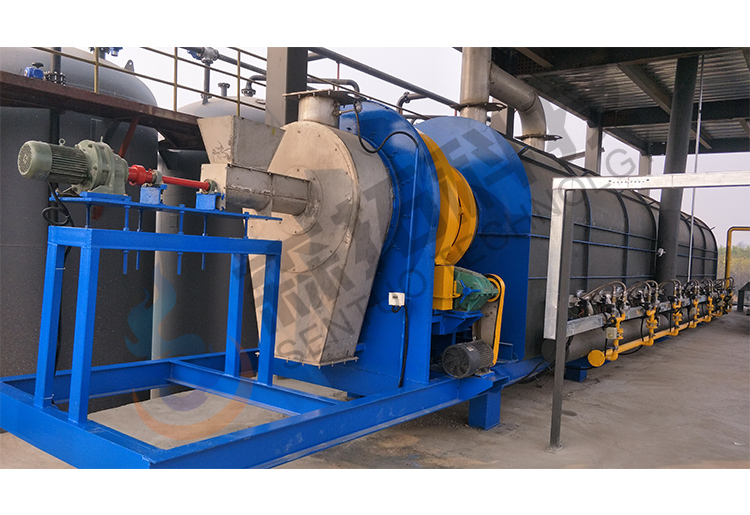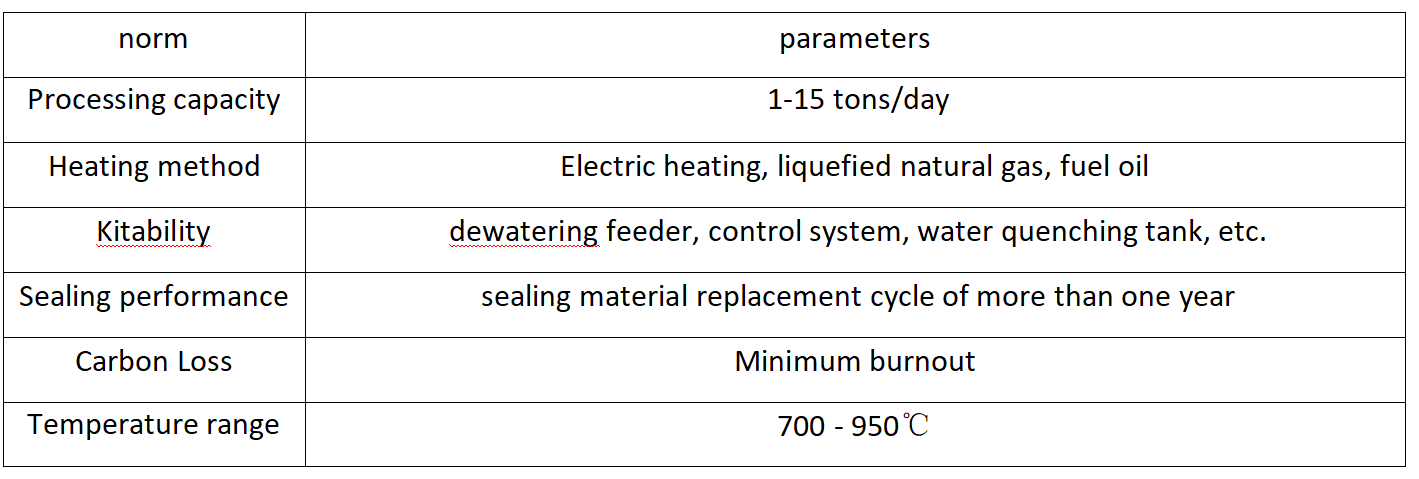
Hotline
+8618073104088
This equipment adopts external heating, the whole regeneration system mainly consists of control system, special heat-resistant stainless steel cylinder, furnace body, feeding and discharging device, mechanical transmission part and heat preservation and other parts. Rotary furnace regeneration of activated carbon, the furnace body in the process of rotary mechanical failure is very small, the operation and management work is relatively simple. It is characterized by: large processing capacity, high degree of automation, continuous feeding and discharging, even and stable quality of regenerated products, easy to operate and control, strong adaptability to the material, and low equipment failure.
I. Stainless steel activated carbon regeneration furnace composition
Activated carbon regeneration rotary furnace is a cylindrical industrial furnace, the cylinder body is heat-resistant stainless steel or heat-resistant alloy. The furnace body is equipped with two rollers and a gear ring, the whole furnace body is supported by two sets of high-strength wheels, driven by the motor reducer, driven by the meshing between the gears to drive the whole furnace body to rotate at a uniform speed and smoothly, so that the material layer and the activation gas in the chamber constantly update the contact surface to ensure that the activation reaction is carried out uniformly. According to the need to install electric heating, oil heating or coal heating device, as well as water vapor inlet, temperature measurement holes, pressure measurement holes, observation holes and into the hole and so on, in order to facilitate the operation and maintenance. One end of the furnace has feeding device and flue gas outlet, and the other end has activated carbon product outlet and cooling device.
Second, the activated carbon regeneration furnace operation process
When the regeneration rotary furnace is working, the material is added into the hopper on the top of the furnace, and fed into the furnace by the feeding device in a quantitative and continuous manner. Driven by the motor reducer, the gears meshing at a constant speed makes the material layer on the furnace bed constantly being turned, the temperature of the material is constantly rising, and the material is constantly moving forward under the push of the spiral of the furnace drum, and finally discharged by the discharge port. The temperature of each section can be adjusted by activating the number of combustion nozzles and their combustion intensity. The water vapor from the water vapor inlet, together with the material in accordance with the completely opposite direction of movement, and the material countercurrent contact for activation; and finally discharged from the flue gas outlet at the top of the furnace and can preheat the wet carbon. The residence time (regeneration time) of the activated carbon in the furnace is controlled by a frequency converter that adjusts the rotational speed of the motor.
In order to realize efficient and reliable regeneration of activated carbon, our company adopts the latest technology to design and manufacture the activated carbon activation regeneration rotary furnace. This furnace has demonstrated its productivity in the worldwide activated carbon regeneration furnace industry. The diameter and length of the furnace have been optimized to achieve different specific functions in separate zones.
1. Drying zone with lifters and sufficient residence time for efficient removal of entrained water from the activated carbon;
2. Organic evaporation zone, to remove organic dirt;
3. Regeneration zone, to reactivate the activated carbon;
4. Cooling zone, to reduce the temperature of the discharged carbon before water quenching.
All of these zones are designed to ensure that each step of the charcoal regeneration process, from feed to discharge, gives sufficient residence time to minimize the charcoal bed thickness and maximize mixing through the use of lifters to ensure that the regeneration efficiency is maximized.
For example if the drying zone is too short or inefficient so that the char still contains entrained moisture into the activation zone, the rapid vaporization of the entrained moisture can lead to chipping and internal cracking of the char. These weaknesses lead to increased wear of the activated char and the creation of pulverized char, thus increasing char losses. The main problem is that the fractured char does not screen out, and in its weakened state can turn into pulverized char during the CIP process. This leads to increased gold losses with activated carbon, which can be a significant source of gold losses regardless of the gold extraction plant.
The diameter of the kiln has also been optimized to ensure that the char depth is minimized and contact between the char and the kiln shell is maximized. It also ensures that the elevator achieves effective waterfall formation and improves contact with the charcoal countercurrent gas phase. These can lead to significant improvements in the performance of the regeneration process.
The countercurrent gas phase is enriched with steam, which is generated by water through nozzles installed at the discharge end. This steam helps to cool the char and plays an important key role in the activation process. This is because the steam is able to both react with the carbon in an activating manner and break down large organic molecules into smaller volatiles. Activated carbon regeneration furnaces that are not injected with steam are far from optimal activation conditions.
The efficient design of the activated carbon regeneration rotary furnace results in less loss of activated carbon, less loss of gold-carrying powdered carbon, and improved activated carbon activity, leading to higher gold recoveries and lower operating costs in the CIP process.
The key to successful activated carbon regeneration also comes from a thorough understanding of the material handling plant. The correct design of a standard CIP plant may not be ideal for the activated carbon used in a flotation plant. As can be seen from the typical charcoal activity diagrams given, proper kiln design, maximizing the partial pressure of the steam, maintaining the correct temperature, and designing the appropriate residence time can significantly increase the relative activity of the char.
In a flotation plant due to the use of xanthic acid and frothing agents can cause contamination of the activated carbon in the next step using the CIP process, so activated carbon regeneration in this case requires more aggressive regeneration conditions, higher temperatures, and steam partial pressures in order to eliminate flotation chemicals. Careful design and optimization of temperature, vapor partial pressure and residence time allow for the efficient removal of both frothing and trapping agents, as well as other contaminants. The efficient design of our activated carbon regeneration rotary furnaces results in less loss of activated carbon, less loss of gold-carrying powdered carbon, and improved activation of activated carbon, resulting in higher gold recoveries and lower operating costs in the CIP process.
The Activated Carbon Regeneration Furnace consists of a complete system of process control with standard PLC and color operator interface to control the burner, variable speed feeder and barrel motor.
